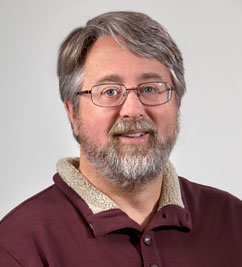Code Talker: David Woods
November 10, 2012

David Woods
David Woods can be found on the third floor of the Educational Sciences building, his face illuminated by six computer monitors arranged in a crescent around his desk. Behind him are five more monitors. Woods, hacking away on a field of keyboards, appears capable of docking the U.S.S. Enterprise into Starfleet Headquarters.
Over the past 10 years, Woods has toiled tirelessly on one project, Transana. Working singlehandedly, he has created an incredibly effective and versatile piece of transcription software used by thousands of researchers across the globe.
In its latest iteration, released in August, Transana allows users to create and code transcripts from video or audio sources. It’s designed to be as flexible as possible, to accommodate a wide range of research, from a project on American inner-city teen mothers to a Swiss study on the mating habits of geckos.
“Anybody using audio or video for their research should be using Transana,” Woods said. “So much can be done with it.”
Transana got its start in 2000, when University of Wisconsin graduate student Chris Fassnacht started coding a program that would allow him to analyze video clips for his doctoral dissertation. Fassnacht, a sociology student and former director of e-services for the Wisconsin Center for Education Research, wrote the majority of the code that would eventually become Transana. When Fassnacht left the university in 2000, he passed on the project to Woods, who had just started a programming job at WCER. Woods agreed to finish the coding and launch the software, under the condition that it be made available to the public.
The first version of Transana was released in 2001, and was offered for free on its website. Woods spread word of the new program through posts on message boards.
“At the time, there were really no established programs that worked with video or audio data. It immediately found an audience amongst people looking for leading analytic tool for that kind of data,” Woods said. “We’ve never done any advertising. Its popularity has spread solely through word of mouth.”
The Transana project found a natural home at WCER, which focuses on facilitating research in education. Over the last 12 years, much of the Transana development work has been funded by subcontracts from other, larger, National Science Foundation-funded projects, such as the Talkbank project at Carnegie Mellon University and the National Partnership for Computational Infrastructure at the San Diego Supercomputer Center. Many of WCER’s existing projects, such as TANGE, AWAKEN, and WIDA are users of Transana software for their transcription needs.
Since its founding, several other programs have emerged that also offer transcription services. However, Transana has separated itself from the pack through its flexibility – particularly a feature that allows users to flag film segments and assign keywords to them. This allows users to quickly find analytically important clips, even in long videos, and to use quantitative methods to compare videos.
“Nested categories lay out what the data has to tell you, even going into such subtleties as gestures or other non-verbal cues,” Woods said. “Then the program can generate reports that show you what your coding looks like to allow you to analyze a much wider range of data than a typical transcript.”
In subsequent releases, Woods has added even more features to Transana, like the ability to synch footage from multiple cameras or other media sources. He’s added simpler ways to identify body movements or speech indicators like rising or falling intonation, audible breath and whispered speech that might be difficult or impossible to code using other transcription software. In the latest version, released in August, users can now take a screenshot from a video and embed it into the transcript, allowing them to contextualize details or descriptions they want to convey in a clearer manner.
“That feature is important because it allows you to bring in more complex and subtle data into the transcript,” Woods said.
Over the years, the funding sources for Transana have changed. “The grants that initially supported the program’s development have gone away,” Woods said. “I needed to find a way to pay for the program, and while I struggled with deciding to charge for the new version, I still think $65 is really cheap for what this software can do.”
Charging for the product allows Woods to maintain pace with the innumerable questions from customers that cross his desk and email inbox each day. Not that Woods is bothered by all the requests he gets.
“When someone comes to me with a problem with Transana, I know I’m going to have a really good day, because a really smart person has been stumped, and I’ll get to figure out how and why,” he said.
Interacting with researchers around the world is one of his favorite parts of the job, he said. Half of Transana’s customers are in Europe, where a huge amount of resources are devoted to qualitative research. Woods jokes – truthfully – that he has more customers in Switzerland than in Wisconsin.
Still, the days are long, as Woods treads water on all the testing, debugging and customer support for Transana, not to mention designing the next, better version of the program.
“Bill Gates said, ‘Software is never finished.’ I’ve certainly learned that’s the case with Transana,” Woods said. “But I hope to keep working on Transana. It is far and away coolest the project ever worked on. From the beginning, it has given researchers the ability to do research they couldn’t do otherwise. And I still don’t think there’s anything else like it on the market.”
For more information on Transana, visit www.Transana.com.


